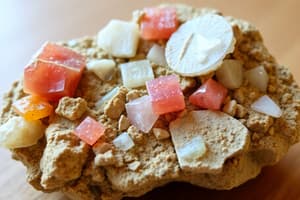Podcast
Questions and Answers
What defines a mineral in terms of its composition and formation?
What defines a mineral in terms of its composition and formation?
A mineral is a natural inorganic substance with a definite chemical composition that is formed in an orderly crystalline structure.
How does the hardness of a mineral relate to its resistance to scratching?
How does the hardness of a mineral relate to its resistance to scratching?
Hardness refers to a mineral's resistance to scratching, indicating that harder minerals can scratch softer ones.
Differentiate between extrusive and intrusive igneous rocks in terms of their formation.
Differentiate between extrusive and intrusive igneous rocks in terms of their formation.
Extrusive igneous rocks form from cooling magma rapidly on the surface, resulting in small crystals, while intrusive igneous rocks cool slowly below the surface, leading to larger crystals.
What are the processes involved in the lithification of sediments into sedimentary rocks?
What are the processes involved in the lithification of sediments into sedimentary rocks?
Describe the significance of cleavage in mineral identification.
Describe the significance of cleavage in mineral identification.
What distinguishes foliated metamorphic rocks from non-foliated ones?
What distinguishes foliated metamorphic rocks from non-foliated ones?
Explain the role of erosion in the rock cycle.
Explain the role of erosion in the rock cycle.
What are endogenic processes, and how do they influence geological structures?
What are endogenic processes, and how do they influence geological structures?
Describe how tension and compression forces differ in their effect on rock layers and provide an example of each.
Describe how tension and compression forces differ in their effect on rock layers and provide an example of each.
Explain the processes involved in metamorphism and how they differ from weathering.
Explain the processes involved in metamorphism and how they differ from weathering.
What role do earthquakes play in relation to faults, and what causes their sudden release of energy?
What role do earthquakes play in relation to faults, and what causes their sudden release of energy?
Analyze the primary differences between exogenic and endogenic processes and their impact on Earth’s landscape.
Analyze the primary differences between exogenic and endogenic processes and their impact on Earth’s landscape.
Define mass wasting and describe an example of a situation where it might occur.
Define mass wasting and describe an example of a situation where it might occur.
Flashcards are hidden until you start studying
Study Notes
Minerals
- Natural inorganic substances with a defined chemical composition, occurring in the Earth's crust.
- Formed naturally, with atoms arranged in orderly crystal structures.
- Properties of minerals:
- Hardness: Indicates resistance to scratching; Diamond is the hardest, and Talc is the softest.
- Color: Can be misleading due to potential surface changes.
- Streak: The color of the mineral powder, which may differ from the surface color.
- Luster: The visual effect of reflected light; categorized as metallic or non-metallic.
- Cleavage vs. Fracture: Cleavage refers to splitting along smooth planes, while fracture indicates irregular breaks.
Rocks
- Naturally occurring aggregates of minerals and mineraloids.
- Rock Cycle: A continuous process of transformation, formation, and destruction of rocks.
Types of Rocks
-
Igneous Rocks:
- Formed from the cooling of magma.
- Extrusive: Cools rapidly on Earth's surface, resulting in small crystals (e.g., Basalt, Rhyolite).
- Intrusive: Cools slowly below the surface, leading to large crystals (e.g., Granite, Diorite).
-
Sedimentary Rocks:
- Result from lithification of sediments.
- Detrital (Clastic): Composed of fragments; classified by grain size.
- Processes:
- Compaction: Sediments are squeezed, reducing pore space.
- Cementation: Sediments bind through mineral precipitation from water.
- Chemical: Formed from precipitated minerals, commonly through chemical weathering.
-
Metamorphic Rocks:
- Developed from pre-existing rocks under heat and pressure.
- Foliated: Features layers or banding.
- Non-Foliated: Lacks distinct layers, appearing more compact.
Erosion
- The process of removing rock or sediment from its location and depositing it elsewhere, facilitated by wind, water, or ice.
Energy-Source Based Processes
-
Endogenic Processes: Originate from beneath the Earth's surface, influenced by internal energy.
- Folding: Bending of rock layers due to compressional forces.
- Faulting: Breakage and displacement of rock; types include:
- Normal Fault: Caused by tension (divergent forces).
- Reverse Fault: Caused by compression (convergent forces).
- Tear Fault: Result of shear forces (transform boundaries).
- Other Endogenic Processes:
- Volcanism: Magma movement to the surface; can be intrusive or extrusive.
- Metamorphism: Rock transformation under pressure and heat.
- Earthquakes: Sudden movements from strain release along faults.
-
Exogenic Processes: Surface processes that shape the Earth's exterior.
- Weathering:
- Physical: Breakdown by physical forces (e.g., freeze-thaw cycles, exfoliation).
- Chemical: Breakdown via chemical reactions (e.g., acid rain).
- Erosion: Transport of weathered materials by wind, water, or ice.
- Mass Wasting: Downward movement of rock and soil due to gravity (e.g., landslides).
- Sedimentation: Depositing eroded materials, leading to new sediment layers.
- Weathering:
Studying That Suits You
Use AI to generate personalized quizzes and flashcards to suit your learning preferences.




